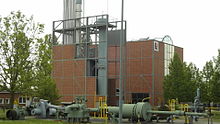University of Merseburg
| University of Merseburg | |
|---|---|

|
|
| founding | 1992 |
| Sponsorship | state |
| place | Merseburg |
| state |
|
| country |
|
| Rector | Jörg Kirbs |
| Students | 2864 WS 2016/17 |
| Employee | 321 |
| Website | hs-merseburg.de |
The Merseburg University of Applied Sciences is a university of applied sciences in Merseburg , Saxony-Anhalt , and was founded on April 1, 1992 on the site of the Technical University of Leuna-Merseburg , which existed from 1954 to 1993 .
history
The University of Applied Sciences Merseburg was founded in Merseburg in 1992 . A university had existed in Merseburg since October 1954, when the later Technical University of Leuna-Merseburg was founded on today's campus . This was abolished in 1993 and largely affiliated to the Martin Luther University Halle-Wittenberg .
In the immediate vicinity of the university towns of Halle (Saale) and Leipzig , the Merseburg University of Applied Sciences offers practical training in Bachelor and Master courses . In the engineering-technical, economic, cultural and social fields, in addition to the scientific basics, methodological knowledge and practical professional qualifications, the so-called key qualifications, are conveyed.
Rectors
- Lothar Teschke , founding rector (1992–1994), professor of mathematics
- Johanna Wanka (1994–2000), professor of engineering mathematics
- Heinz Zwanziger (2000–2012), Professor of Analytical Chemistry
- Jörg Kirbs (since 2012), Professor of Technical Mechanics.
courses
Since the 2005/2006 winter semester , only Bachelor and Master courses have been offered. The diploma courses are currently running out. There is also an extensive range of further training courses.
Bachelor courses
- Applied computer science
- Automation technology / information technology
- Business administration
- Business administration in distance learning
- Chemical and environmental technology
- Green engineering
- Engineering education
- Culture and media education
- Mechanical engineering | Mechatronics | Physics engineering
- Social work
- Technical information design
- business Informatics
- Industrial engineering ( dual course)
- Industrial engineering (focus on management )
Masters courses
- Applied media and cultural studies
- Applied Sexology
- Chemical and environmental engineering
- Controlling and Management
- Computer science and communication systems
- Information design and media management
- Mechanical engineering | Mechatronics | Physics engineering
- Polymer Materials Science
- Project management
- Sexology (master's degree in sexual science)
- Tax and accounting (dual degree program)
- Systemic social work
- business Informatics
- industrial engineering
Departments
- Engineering and natural sciences
- Social work . Media . Culture
- Economics and Information Sciences .
Partnerships
-
 State Rittmeister-Witold-Pilecki-Hochschule Oświęcim (Państwowa Wyższa Szkoła Zawodowa im. Rotmistrza Witolda Pileckiego w Oświęcimiu), Poland
State Rittmeister-Witold-Pilecki-Hochschule Oświęcim (Państwowa Wyższa Szkoła Zawodowa im. Rotmistrza Witolda Pileckiego w Oświęcimiu), Poland
German Chemistry Museum Merseburg
The German Chemical Museum Merseburg (dchm) was founded in 1993 on the Merseburg campus to present the development of the chemical industry in Central Germany using original systems, apparatus and equipment (large-scale companies with a long tradition: Leuna-Werke and Buna-Werke ). The association “Sachzeugen der chemical Industrie e. V. (SCI) ”established and managed museum works closely with the University of Merseburg.
The collection created under the direction of Klaus Krug consists of approx. 5000 objects, of which more than 300 can be viewed in a technology park . The most important original exhibits are the ammonia synthesis chamber and the associated functional high-pressure circulation pump , both from the early years of large-scale ammonia synthesis in the Leuna plant in 1916/1917 using the Haber-Bosch process (later Nobel prizes for the chemist Fritz Haber in 1919 and the Chemist, technician and industrialist Carl Bosch in 1931).
The SCI association has conceptually ensured that this museum combines the features of a science center , a museum and a collection of original plants and apparatus from the chemical industry of the 20th century in a technology park . Since 1996 the projects "Chemistry you can touch" and "Understand technology" have been realized in cooperation with the University of Merseburg. The chairman of the board of the SCI development association is Thomas Martin , professor for process engineering / mechanical and thermal processes at the University of Merseburg.
The German Chemistry Museum Merseburg on the university campus is unique in Europe and is world-class.
Web links
Individual evidence
- ↑ University website , accessed on April 10, 2019.
- ^ Merseburg University of Applied Sciences . Accessed January 10, 2015.
Coordinates: 51 ° 20 ′ 40.5 ″ N , 11 ° 58 ′ 40.8 ″ E


